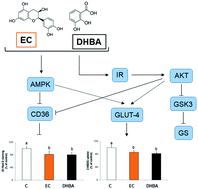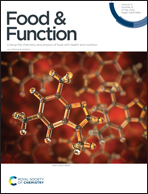Metabolic regulation of (−)-epicatechin and the colonic metabolite 2,3-dihydroxybenzoic acid on the glucose uptake, lipid accumulation and insulin signalling in cardiac H9c2 cells
Abstract
Epicatechin (EC) and main colonic phenolic acids derived from flavonoid intake have been suggested to exert healthful effects, although their mechanism of action remains unknown. Heart damage is highly prevalent in metabolic diseases, and the failure of this organ is a major cause of death worldwide. In this study, the modulation of the energy metabolism and insulin signalling by the mentioned compounds in cardiac H9c2 cells was evaluated. Incubation of cells with EC (1–20 μM) and 2,3-dihydroxybenzoic acid (DHBA, 10 μM) reduced glucose uptake, and both compounds decreased lipid accumulation at concentrations higher than 0.5 μM. EC and DHBA also increased the tyrosine phosphorylated and total insulin receptor (IR) levels, and activated the phosphatidylinositol 3-kinase (PI3K)/protein kinase B (AKT) pathway in cardiac H9c2 cells. Interestingly, EC and DHBA did not modify glucose transporters (SGLT-1 and GLUT-1) levels, and increased GLUT-4 values. In addition, EC and DHBA decreased cluster of differentiation 36 (CD36) and fatty acid synthase (FAS) values, and enhanced carnitine palmitoyl transferase 1 (CPT1) and proliferator activated receptor α (PPARα) levels. By using specific inhibitors of AKT and 5′-AMP-activated protein kinase (AMPK), the participation of both proteins in EC- and DHBA-mediated regulation on glucose uptake and lipid accumulation was shown. Taken together, EC and DHBA modulate glucose uptake and lipid accumulation via AKT and AMPK, and reinforce the insulin signalling by activating key proteins of this pathway in H9c2 cells.



 Please wait while we load your content...
Please wait while we load your content...